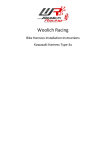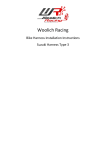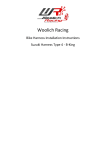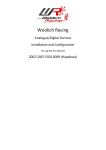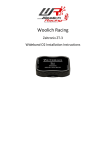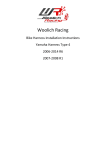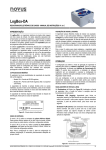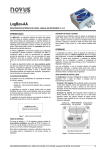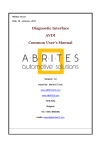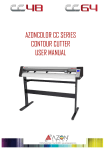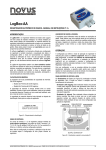Download Log Box (Denso) v1 User Guide
Transcript
Woolich Racing
Log Box
User Guide
1) Introduction
This user guide covers how to use the Woolich Racing Log Box, including:
Connecting the Log Box to the Bike Harness
Micro SD Card
Updating the firmware
Installing the FTDI Drivers
Data Logging Mode
Log Box Configuration
Engine Data Mode
ECU Flashing Mode
Disconnecting the Log Box
2) Connecting the Log Box
i)
ii)
You need to install the Bike Harness before you can use the Log Box. You can download
model specific instructions for the Bike Harness Installation from our web site
http://www.WoolichRacing.com/Documents.aspx
Plug the 8 pin white Molex connector into the Bike Harness.
3) Micro SD Card
The Log Box comes with a 2GB micro SD card. This card will allow you to log approximately 350
hours of engine data at the fast baud rate (every 52ms). There is a provision in the plastic case to
remove the micro SD card however, we do not recommend regular removal of the micro SD card.
The micro SD card contents are available when you plug the log box into your computer via the
supplied USB cable.
4) Updating the firmware
The firmware (software) that runs on the Log Box is easily updateable to allow you to install future
enhancements. The Log Box comes preinstalled with the latest version of the firmware.
To update the firmware:
1) Download the latest version of the firmware from the Woolich Racing web site
http://woolichracing.com/downloads.aspx
2) Plug the Log Box into your computer using the suppled USB cable
3) Save the file “firmware.bin” to the Log Box
4) The next time the Log Box starts the firmware will be updated
5) Installing the FTDI Drivers
To install the FTDI drivers you should move the Mode Selection switch into either Engine Data mode
(mode selection switch right) or ECU Flashing mode (mode selection switch left).
Windows 7
On Windows 7 computers the Log Box should be automatically detected and installed onto the
computer. All you need to do is plug the Log Box into the computer’s USB port and the relevant
drivers will be downloaded, installed and configured onto your computer. If you experience any
difficulty refer to the FTDI Installation Guides below.
Windows XP
On Windows XP computers you may need to download and install the drivers for the Log Box
from the following location:
http://www.ftdichip.com/Drivers/CDM/CDM20814_Setup.exe
FTDI Installation Guides
Installation guides for various operating systems can be found on the FTDI site:
http://www.ftdichip.com/Support/Documents/InstallGuides.htm
6) Data Logging Mode
To select the Data Logging Mode, make sure the USB Cable is unplugged and move the mode
selection switch to the centre position.
The Log Box has several statuses while in Data Logging Mode:
1) Connecting to the ECU: The green status LED will flash 3 times in fast bursts followed by a
pause while connecting to the ECU.
2) Connected to ECU waiting to begin Logging: Once the Log Box has connected to the ECU it
will go into wait state until the Log Box Configuration settings are met. While in wait state
the green status LED will flash slowly every 2 second.
The Log Box Configuration can be modified using ecueditor (see next section). By default the
values are:
a. 5 second delay
b. Engine Running
c. Coolant Temp greater than 75’C (167’F)
3) Logging Data: Once the Log Box Configuration settings have been met, the Log Box will
automatically start to log data. The green LED will flash every 1 second. Log files are stored
with a numeric file name starting at 0001.WRL, each new log file is named higher than the
last logged file i.e. 0001.WRL, 0002.WRL etc.
4) USB Mass Storage: If you plug a USB cable into the Log Box data logging will stop and the Log
Box will go into USB Mass Storage mode. The device will appear on your computer as an
external USB Mass Storage Device (hard drive). You will be able to open the Log Box like any
other hard drive on your computer and directly read off the Woolich Racing Log Files (.WRL
files).
7) Log Box Configuration
There are 3 configuration settings that can be modified for the Log Box:
1) Log Start Delay: how many seconds to delay logging
2) Engine Running: determines if the engine should be running before starting to log data.
3) Coolant Temp: sets the temperature the coolant temperature needs to reach before starting
to log data.
These settings are controlled by a file on the Log Box called LOGBOX.CFG. You can easily edit this file
with http://www.ecueditor.com
Bike Interface Menu -> Woolich Racing Log Box Config
Choose the location of the LOGBOX.CFG file
Click Open and modify the Log Box Configuration as required.
Click OK to save the configuration to the LOGBOX.CFG file.
The next time your Log Box starts, it will use the new configuration settings.
8) Engine Data Mode
To select Engine Data Mode, move the mode selection switch to the left position. When in Engine
Data Mode the Orange LED will be on.
9) ECU Flashing Mode
To select ECU Flashing Mode, move the mode selection switch to the right position. When in ECU
Flashing Mode the Red LED will be on.
10) Disconnecting the Log Box
The Log Box, when plugged in, will log engine data every time you ride your bike. Woolich Racing
recommends disconnecting and removing the Log Box when not in use.
To Disconnect the Log Box from the ECU, unplug the 8 pin Molex connector between the ECU
harness and the Log Box.
Warranty
Woolich Racing Warranty obligations are limited to the terms set forth below.
Woolich Racing warrants this product against defects in material and workmanship for the period of one (1) year. The
warranty period begins with the date of original retail purchase.
This limited warranty is made only to the original end user purchaser ("you") of the product and does not extend to any
subsequent purchasers or owners of the product. The "original end user" is the first user to put the product into service in
any fashion. It is your responsibility to establish the warranty period by verifying the original purchase date.
If you discover a defect, Woolich Racing will, at its option, repair or replace this product with a new or reconditioned
product at no charge to you, provided you return it during the warranty period, with transportation charges prepaid, to
Woolich Racing. Please attach your name, address, telephone number, and a copy of the receipt from Paypal as proof of
date of original purchase, as well as a detailed description of the problem for which service is requested. You are
responsible for packing the product to be returned. If the repairs are covered by the Limited Warranty and if the product
was properly shipped to Woolich Racing, Woolich Racing will pay the return shipping charges. This warranty applies only to
Woolich Racing products. This warranty does not cover damaged resulting from accident, misuse, abuse, or neglect and/or
damage during any type of transportation resulting from improper packaging; damage to any product which has been
altered in any fashion, including damage resulting from causes other than product defects, including and not by way of
limitation, lack of technical skill, competence, or experience of the user, and/or failure to use the product in accordance
with the instructions provided in the User's Manual or Installation Manual; and service performance by an unauthorized
person or entity. Any implied warranties including fitness for use and merchantability are limited to the period of the
expressed warranty set forth above. The remedies provided under this warranty are exclusive and in lieu of all others.
Disclaimer
This product is meant for Off-Road use only and is not street legal. Owner assumes responsibility for his or her own actions
when using this product. Woolich Racing hereby expressly disclaims liability and shall not be responsible for incidental,
consequential and contingent damages or any kind or nature, including, without limitation: damages to persons or
property, whether a claim for such damages is based upon warranty, contract, tort or otherwise; damages due to or arising
out of the loss of time; or loss of profits. Woolich Racing shall not be responsible for any damages caused by the presence
of error or omission in any of its manuals, instructions or related materials.








